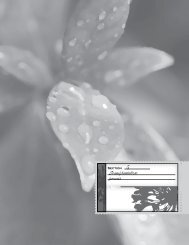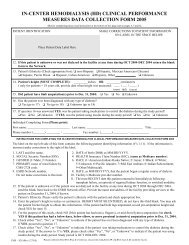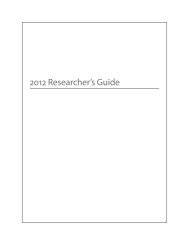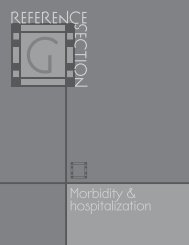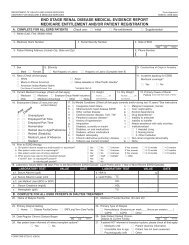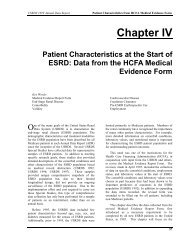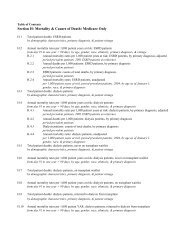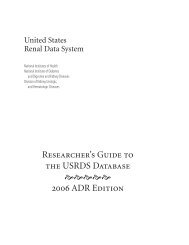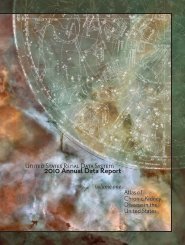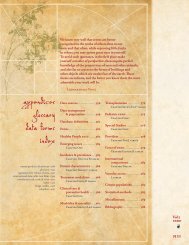CMS 2728-ESRD Medical Evidence Report Medicare Entitlement ...
CMS 2728-ESRD Medical Evidence Report Medicare Entitlement ...
CMS 2728-ESRD Medical Evidence Report Medicare Entitlement ...
You also want an ePaper? Increase the reach of your titles
YUMPU automatically turns print PDFs into web optimized ePapers that Google loves.
U.S. DEPARTMENT OF HEALTH & HUMAN SERVICES<br />
FORM APPROVED<br />
CENTERS FOR MEDICARE & MEDICAID SERVICES OMB NO. 0938-0046<br />
END STAGE RENAL DISEASE MEDICAL EVIDENCE REPORT<br />
MEDICARE ENTITLEMENT AND/OR PATIENT REGISTRATION<br />
A. COMPLETE FOR ALL <strong>ESRD</strong> PATIENTS<br />
1. Name (Last, First, Middle Initial)<br />
2. Health Insurance Claim Number 3. Social Security Number<br />
4. Full Address (Include City, State, and Zip) 5. Phone Number<br />
( )<br />
6. Date of Birth<br />
_________/_________/_________<br />
MM DD YYYY<br />
7. Sex 8. Ethnicity<br />
■ Male ■ Female ■ Hispanic: Mexican ■ Hispanic: Other ■ Non-Hispanic<br />
9. Race (Check one box only) 10. <strong>Medical</strong> Coverage (Check all that apply)<br />
■ White<br />
■ Mid-East/Arabian a. ■ Medicaid e. ■ Other <strong>Medical</strong> Insurance<br />
■ Black<br />
■ Indian sub-Continent b. ■ DVA f. ■ None<br />
■ American Indian/Alaskan Native ■ Other, specify _____ c. ■ <strong>Medicare</strong><br />
■ Asian<br />
________________ d. ■ Employer Group Health Insurance<br />
■ Pacific Islander<br />
■ Unknown<br />
11. Is Patient Applying for <strong>ESRD</strong> <strong>Medicare</strong> Coverage (if YES, enter address of Social Security office)<br />
■ Yes ■ No<br />
CITY STATE ZIP<br />
12. Primary Cause of Renal Failure (Use code from back of form) 13. Height 14. Dry Weight<br />
17. Was pre-dialysis/transplant EPO administered<br />
■ Yes ■ No<br />
18. Laboratory Values Prior to First Dialysis Treatment or Transplant *See Instructions.<br />
LABORATORY TEST VALUE DATE<br />
LABORATORY TEST VALUE DATE<br />
a. Hematocrit (%)<br />
e. Serum Creatinine (mg/dl)<br />
b. Hemoglobin (g/dl)*<br />
f. Creatinine Clearance (ml/min)*<br />
c. Serum Albumin (g/dl)<br />
g. BUN (mg/dl)*<br />
d. Serum Albumin Lower Limit (g/dl)<br />
h. Urea Clearance (ml/min)*<br />
INCHES<br />
OR CENTIMETERS<br />
B. COMPLETE FOR ALL <strong>ESRD</strong> PATIENTS IN DIALYSIS TREATMENT<br />
19. Name of Provider 20. <strong>Medicare</strong> Provider Number<br />
POUNDS OR KILOGRAMS<br />
15. Employment Status (6 mos. prior and 16. Co-Morbid Conditions (Check ALL that apply currently or during last 10 years) *See instructions<br />
current status) a. ■ Congestive heart failure<br />
k. ■ Diabetes, currently on insulin<br />
b. ■ Ischemic heart disease, CAD* l. ■ Chronic obstructive pulmonary disease<br />
■ ■ Unemployed<br />
c. ■ Myocardial infarction<br />
m. ■ Tobacco use (current smoker)<br />
■ ■ Employed Full Time<br />
d. ■ Cardiac arrest<br />
n. ■ Malignant neoplasm, Cancer<br />
■ ■ Employed Part Time<br />
e. ■ Cardiac dysrhythmia<br />
o. ■ Alcohol dependence<br />
■ ■ Homemaker<br />
f. ■ Pericarditis<br />
p. ■ Drug dependence*<br />
■ ■ Retired due to Age/Preference g. ■ Cerebrovascular disease, CVA, TIA* q. ■ HIV positive status ■ Can’t Disclose<br />
■ ■ Retired (Disability)<br />
h. ■ Peripheral vascular disease* r. ■ AIDS ■ Can’t Disclose<br />
■ ■ <strong>Medical</strong> Leave of Absence i. ■ History of hypertension<br />
s. ■ Inability to ambulate<br />
■ ■ Student<br />
j. ■ Diabetes (primary or contributing) t. ■ Inability to transfer<br />
Prior<br />
Current<br />
21. Primary Dialysis Setting 22. Primary Type of Dialysis<br />
■ Hospital Inpatient ■ Dialysis Facility/Center ■ Home ■ Hemodialysis ■ IPD ■ CAPD ■ CCPD ■ Other<br />
23. Date Regular Dialysis Began 24. Date Patient Started Chronic Dialysis at Current Facility<br />
_________/_________/_________<br />
MM DD YY<br />
25. Date Dialysis Stopped 26. Date of Death<br />
<strong>CMS</strong>-<strong>2728</strong>-U3 (6-97)<br />
_________/_________/_________<br />
MM DD YY<br />
_________/_________/_________<br />
MM DD YY<br />
_________/_________/_________<br />
MM DD YY
C. COMPLETE FOR ALL KIDNEY TRANSPLANT PATIENTS<br />
27. Date of Transplant 28. Name of Transplant Hospital 29. <strong>Medicare</strong> Provider Number for Item 28<br />
_________/_________/_________<br />
MM DD YY<br />
Date patient was admitted as an inpatient to a hospital in preparation for, or anticipation of, a kidney transplant prior to the<br />
date of actual transplantation.<br />
30. Enter Date 31. Name of Preparation Hospital 32. <strong>Medicare</strong> Provider Number for Item 31<br />
_________/_________/_________<br />
MM DD YY<br />
33. Current Status of Transplant<br />
■ Functioning ■ Non-Functioning<br />
34. If Nonfunctioning, Date of Return To Regular Dialysis 35. Current Dialysis Treatment Site<br />
_________/_________/_________<br />
■ Hospital Inpatient ■ Dialysis Facility/Center ■ Home<br />
MM DD YY<br />
D. COMPLETE FOR ALL <strong>ESRD</strong> SELF-DIALYSIS TRAINING PATIENTS (MEDICARE APPLICANTS ONLY)<br />
36. Name of Training Provider 37. <strong>Medicare</strong> Provider Number of Training Provider<br />
38. Date Training Began 39. Type of Training<br />
_________/_________/_________<br />
■ Hemodialysis ■ IPD ■ CAPD ■ CCPD<br />
MM DD YY<br />
40. This Patient is Expected to Complete (or has completed) Training<br />
41. Date When Patient Completed, or is Expected to Complete, Training<br />
and Will Self-dialyze on a Regular Basis.<br />
_________/_________/_________<br />
■ Yes ■ No<br />
MM DD YY<br />
I certify that the above self-dialysis training information is correct and is based on consideration of all pertinent<br />
medical, psychological, and sociological factors as reflected in records kept by this training facility.<br />
42. Printed Name and Signature of Physician Personally Familiar with the Patient's Training 43. UPIN of Physician in Item 42<br />
E. PHYSICIAN IDENTIFICATION<br />
44. Attending Physician (Print) 45. Physician's Phone No. 46. UPIN of Physician in Item 44<br />
PHYSICIAN ATTESTATION<br />
I certify, under penalty of perjury, that the information on this form is correct to the best of my knowledge and belief.<br />
Based on diagnostic tests and laboratory findings, I further certify that this patient has reached the stage of renal<br />
impairment that appears irreversible and permanent and requires a regular course of dialysis or kidney transplant to<br />
maintain life. I understand that this information is intended for use in establishing the patient's entitlement to<br />
<strong>Medicare</strong> benefits and that any falsification, misrepresentation, or concealment of essential information may subject<br />
me to fine, imprisonment, civil penalty, or other civil sanctions under applicable Federal laws.<br />
47. Attending Physician's Signature of Attestation (Same as Item 44) 48. Date<br />
49. Remarks<br />
( )<br />
_________/_________/_________<br />
MM DD YY<br />
F. OBTAIN SIGNATURE FROM PATIENT<br />
I hereby authorize any physician, hospital, agency, or other organization to disclose any medical records or other<br />
information about my medical condition to the Department of Health and Human Services for purposes of reviewing<br />
my application for <strong>Medicare</strong> entitlement under the Social Security Act and/or for scientific research.<br />
50. Signature of Patient (Signature by Mark Must Be Witnessed.) 51. Date<br />
G. PRIVACY ACT STATEMENT<br />
The collection of this information is authorized by section 226A of the Social Security Act. The information provided will be used to determine if an individual is entitled to <strong>Medicare</strong> under the End Stage<br />
Renal Disease provisions of the law. The information will be maintained in system No. 09-70-0520, "End Stage Renal Disease Program Management and <strong>Medical</strong> Information System (<strong>ESRD</strong> PMMIS)",<br />
published in the Privacy Act Issuance, 1991 Compilation, Vol. 1, pages 436–437, December 31, 1991, or as updated and republished. Collection of your Social Security number is authorized by<br />
Executive Order 9397. Furnishing the information on this form is voluntary, but failure to do so may result in denial of <strong>Medicare</strong> benefits. Information from the <strong>ESRD</strong> PMMIS may be given to a<br />
congressional office in response to an inquiry from the congressional office made at the request of the individual; an individual or organization for a research, demonstration, evaluation, or<br />
epidemiologic project related to the prevention of disease or disability, or the restoration or maintenance of health. Additional disclosures may be found in the Federal Register notice cited above.<br />
You should be aware that P.L. 100-503, the Computer Matching and Privacy Protection Act of 1988, permits the government to verify information by way of computer matches.<br />
H. FOR <strong>ESRD</strong> NETWORK USE ONLY IN CASES REFERRED TO <strong>ESRD</strong> MEDICAL REVIEW BOARD<br />
52. Network Confirmed as <strong>ESRD</strong> 53. Authorized Signature 54. Date 55. Network Number<br />
_________/_________/_________<br />
MM DD YY<br />
■ Yes<br />
<strong>CMS</strong>-<strong>2728</strong>-U3 (6-97)<br />
■ No<br />
_________/_________/_________<br />
MM DD YY
LIST OF PRIMARY CAUSES OF END STAGE RENAL DISEASE<br />
Item 12. Primary Cause of Renal Failure should be completed by the attending physician from the list below. Enter the<br />
ICD-9-CM code plus the letter code to indicate the primary cause of end stage renal disease. If there are several probable<br />
causes of renal failure, choose one as primary.<br />
ICD-9 LTR NARRATIVE ICD-9 LTR NARRATIVE<br />
DIABETES<br />
25000 A Type II, adult-onset type or unspecified type diabetes<br />
25001 A Type I, juvenile type, ketosis prone diabetes<br />
GLOMERULONEPHRITIS<br />
5829 A Glomerulonephritis (GN)<br />
(histologically not examined)<br />
5821 A Focal glomerulosclerosis, focal sclerosing GN<br />
5831 A Membranous nephropathy<br />
5832 A Membranoproliferative GN type 1, diffuse MPGN<br />
5832 C Dense deposit disease, MPGN type 2<br />
58381 B IgA nephropathy, Berger’s disease<br />
(proven by immunofluorescence)<br />
58381 C IgM nephropathy (proven by immunofluorescence)<br />
5804 B Rapidly progressive GN<br />
5834 C Goodpasture’s Syndrome<br />
5800 C Post infectious GN, SBE<br />
5820 A Other proliferative GN<br />
SECONDARY GN/VASCULITIS<br />
7100 E Lupus erythematosus, (SLE nephritis)<br />
2870 A Henoch-Schonlein syndrome<br />
7101 B Scleroderma<br />
2831 A Hemolytic uremic syndrome<br />
4460 C Polyarteritis<br />
4464 B Wegener’s granulomatosis<br />
5839 C Nephropathy due to heroin abuse and related drugs<br />
4462 A Vasculitis and its derivatives<br />
5839 B Secondary GN, other<br />
INTERSTITIAL NEPHRITIS/PYELONEPHRITIS<br />
9659 A Analgesic abuse<br />
5830 B Radiation nephritis<br />
9849 A Lead nephropathy<br />
5909 A Nephropathy caused by other agents<br />
27410 A Gouty nephropathy<br />
5920 C Nephrolithiasis<br />
5996 A Acquired obstructive uropathy<br />
5900 A Chronic pyelonephritis, reflux nephropathy<br />
58389 B Chronic interstitial nephritis<br />
58089 A Acute interstitial nephritis<br />
5929 B Urolithiasis<br />
2754 A Nephrocalcinosis<br />
HYPERTENSION/LARGE VESSEL DISEASE<br />
4039 D Renal disease due to hypertension<br />
(no primary renal disease)<br />
4401 A Renal artery stenosis<br />
59381 B Renal artery occlusion<br />
59381 E Cholesterol emboli, renal emboli<br />
CYSTIC/HEREDITARY/CONGENITAL DISEASES<br />
75313 A Polycystic kidneys, adult type (dominant)<br />
75314 A Polycystic, infantile (recessive)<br />
75316 A Medullary cystic disease, including nephronophthisis<br />
7595 A Tuberous sclerosis<br />
7598 A Hereditary nephritis, Alport’s syndrome<br />
2700 A Cystinosis<br />
2718 B Primary oxalosis<br />
2727 A Fabry’s disease<br />
7533 A Congenital nephrotic syndrome<br />
5839 D Drash syndrome, mesangial sclerosis<br />
7532 A Congenital obstructive uropathy<br />
7530 B Renal hypoplasia, dysplasia, oligonephronia<br />
7567 A Prune belly syndrome<br />
7598 B Hereditary/familial nephropathy<br />
NEOPLASMS/TUMORS<br />
1890 B Renal tumor (malignant)<br />
1899 A Urinary tract tumor (malignant)<br />
2230 A Renal tumor (benign)<br />
2239 A Urinary tract tumor (benign)<br />
2395 A Renal tumor (unspecified)<br />
2395 B Urinary tract tumor (unspecified)<br />
20280 A Lymphoma of kidneys<br />
2030 A Multiple myeloma<br />
2030 B Light chain nephropathy<br />
2773 A Amyloidosis<br />
99680 A Complication post bone marrow or other transplant<br />
MISCELLANEOUS CONDITIONS<br />
28260 A Sickle cell disease/anemia<br />
28269 A Sickle cell trait and other sickle cell (HbS/Hb other)<br />
64620 A Post partum renal failure<br />
0429 A AIDS nephropathy<br />
8660 A Traumatic or surgical loss of kidney(s)<br />
5724 A Hepatorenal syndrome<br />
5836 A Tubular necrosis (no recovery)<br />
59389 A Other renal disorders<br />
7999 A Etiology uncertain<br />
<strong>CMS</strong>-<strong>2728</strong>-U3 (6-97)
INSTRUCTIONS FOR COMPLETION OF END STAGE RENAL DISEASE MEDICAL EVIDENCE REPORT<br />
MEDICARE ENTITLEMENT AND/OR PATIENT REGISTRATION<br />
For whom should this form be completed:<br />
This form SHOULD NOT be completed for those patients<br />
who are in acute renal failure. Acute renal failure is a<br />
condition in which kidney function can be expected to recover<br />
after a short period of dialysis; i.e., several weeks or months.<br />
This form MUST BE completed within 45 days for ALL<br />
patients beginning any of the following:<br />
A. For all patients who initially receive a kidney transplant<br />
instead of a course of dialysis.<br />
B. All patients for whom a regular course of dialysis has<br />
been prescribed by a physician because they have<br />
reached that stage of renal impairment that a kidney<br />
transplant or regular course of dialysis is necessary<br />
to maintain life. The first date of a regular course of<br />
dialysis is the date this prescription is implemented<br />
whether as an inpatient of a hospital, an outpatient in a<br />
dialysis center or facility, or a home patient. This form<br />
should be completed for all patients in this category even<br />
if the patient dies within this time period.<br />
C. For beneficiaries who have already been entitled to<br />
<strong>ESRD</strong> <strong>Medicare</strong> benefits and those benefits were<br />
To be terminated signed by the because patient. their coverage stopped 3 years post<br />
transplant but now are again applying for <strong>Medicare</strong><br />
<strong>ESRD</strong> benefits because they returned to dialysis or<br />
received another kidney transplant.<br />
D. For beneficiaries who stopped dialysis for more than 12<br />
months, have had their <strong>Medicare</strong> <strong>ESRD</strong> benefits<br />
terminated and now returned to dialysis or received a<br />
kidney transplant. These patients will be reapplying for<br />
<strong>Medicare</strong> benefits.<br />
All Items except as follows: To be completed by the attending physician, head nurse, or social worker involved in this<br />
patient's treatment of renal disease.<br />
Items 12, 16, 47-48: To be completed by the attending physician.<br />
Item 42: To be signed by the attending physician or the physician familiar with the patient's self-care dialysis training.<br />
Items 50 and 51: To be signed and dated by the patient.<br />
1. Enter the patient’s legal name (Last, first, middle initial). Name<br />
should appear exactly the same as it appears on patient’s<br />
Social Security or <strong>Medicare</strong> card.<br />
2. If the patient is covered by <strong>Medicare</strong>, enter his/her Health<br />
Insurance Claim Number as it appears on his/her <strong>Medicare</strong><br />
card. This number can be verified from his/her <strong>Medicare</strong> card.<br />
3. Enter the patient’s own Social Security number. This number<br />
can be verified from his/her Social Security card.<br />
4. Enter the patient’s mailing address (number and street or post<br />
office box number, city, State, and ZIP code).<br />
5. Enter the patient’s home area code and telephone number.<br />
6. Enter patient’s date of birth (2-digit Month, Day, and 4-digit<br />
Year). Example 07/25/1950.<br />
7. Check the appropriate block to identify sex.<br />
8. Check the appropriate block to identify ethnicity. Definitions of<br />
the basic ethnicity categories for Federal statistics are as<br />
follows:<br />
Hispanic: Mexican—A person of Mexican culture or origin,<br />
regardless of race.<br />
Hispanic: Other—A person of Puerto Rican, Cuban, Central or<br />
South American, or other Spanish culture or origin, regardless<br />
of race.<br />
Non-Hispanic—A person of culture or origin not described<br />
above, regardless of race.<br />
9. Check one appropriate block to identify race. Definitions of the<br />
basic racial categories for Federal statistics are as follows:<br />
White—A person having origins in any of the original white<br />
peoples of Europe.<br />
Black—A person having origins in any of the black racial<br />
groups of Africa.<br />
American Indian/Alaskan Native—A person having origins in<br />
any of the original peoples of North America, and who<br />
maintains cultural identification through tribal affiliation or<br />
community recognition.<br />
Asian—A person having origins in any of the original peoples<br />
of the Far East and Southeast Asia. Examples of this area<br />
include China, Japan and Korea.<br />
Pacific Islander—A person having origins in any of the<br />
peoples of the Pacific Islands. Examples of this area include<br />
the Philippine Islands, Samoa and Hawaiian Islands.<br />
Mid-East/Arabian—A person having origins in any of the<br />
peoples of the Middle East and Northern Africa. Examples of<br />
this area include Egypt, Israel, Iran, Iraq, Saudi Arabia, Jordan,<br />
and Kuwait.<br />
Indian Sub-Continent—A person having origins in any of the<br />
peoples of the Indian Sub-continent. Examples of this area<br />
include India and Pakistan.<br />
Other, specify—A person not having origins in any of the<br />
above categories. Write race(s) in space provided.<br />
Unknown—Check this block if race is unknown.<br />
10. Check all the blocks that apply to this patient’s current medical<br />
insurance status.<br />
<strong>Medicare</strong>—Patient is currently entitled to Federal <strong>Medicare</strong><br />
benefits.<br />
Medicaid—Patient is currently receiving State Medicaid<br />
benefits.<br />
DISTRIBUTION OF COPIES:<br />
• Forward the first part (blue) of this form to the Social Security office servicing the claim.<br />
• Forward the second (green) of this form to the <strong>ESRD</strong> Network Coordinating Council.<br />
• Retain the last part (white) in the patient's medical records file.<br />
According to the Paperwork Reduction Act of 1995, no persons are required to a collection of information unless it displays a valid OMB<br />
control number. The valid OMB control number for this information is 0938-0046. The time required to complete this information collection<br />
is estimated to average 25 minutes per response, including the time to review instructions, search existing data resources, gather the data<br />
needed, and complete and review the information collection. If you have any comments concerning the accuracy of the time estimate(s) or<br />
suggestions for improving this form, please write to: <strong>CMS</strong>, 7500 Security Boulevard, N2-14-26, Baltimore, Maryland 21244-1850.<br />
<strong>CMS</strong>-<strong>2728</strong>-U3 (6-97)
DVA—Patient is receiving medical care from a Department of<br />
Veterans Affairs facility.<br />
Employer Group Health Insurance—Patient receives medical<br />
benefits through an employer group health plan that covers<br />
employees, former employees, or the families of employees or<br />
former employees.<br />
Other <strong>Medical</strong> Insurance—Patient is receiving medical<br />
benefits under a health insurance plan that is not <strong>Medicare</strong>,<br />
Medicaid, Department of Veterans Affairs, nor an employer<br />
group health insurance plan. Examples of other medical<br />
insurance are Railroad Retirement and CHAMPUS<br />
beneficiaries.<br />
None—Patient has no medical insurance plan.<br />
11. Check the appropriate yes or no block to indicate if patient is<br />
applying for <strong>ESRD</strong> <strong>Medicare</strong>. Note: Even though a person<br />
may already be entitled to general <strong>Medicare</strong> coverage, he<br />
should re-apply for <strong>ESRD</strong> <strong>Medicare</strong> coverage. If answer is<br />
yes, enter the address of the local Social Security office<br />
(street address, city, State and zip code) where patient will<br />
be applying for benefits.<br />
12. To be completed by the attending physician. Enter the<br />
ICD-9-CM plus letter code from back of form to indicate the<br />
primary cause of end stage renal disease. These are the<br />
only acceptable causes of end stage renal disease.<br />
13. Enter the patient’s most recent recorded height in inches OR<br />
centimeters at time form is being completed. If entering<br />
height in centimeters, round to the nearest centimeter.<br />
Estimate or use last known height for those unable to be<br />
measured. (Example of inches - 62. DO NOT PUT 5’2")<br />
NOTE: For amputee patients, enter height prior to amputation.<br />
14. Enter the patient’s most recent recorded dry weight in<br />
pounds OR kilograms at time form is being completed. If<br />
entering weight in kilograms, round to the nearest kilogram.<br />
NOTE: For amputee patients, enter actual dry weight.<br />
15. Check the first box to indicate employment status 6 months<br />
prior to renal failure and the second box to indicate current<br />
employment status. Check only one box for each time<br />
period. If patient is under 6 years of age, leave blank.<br />
16. To be completed by the attending physician. Check all<br />
co-morbid conditions that apply.<br />
*Ischemic heart disease includes prior coronary artery<br />
bypass (CABG), angioplasty and diagnoses of coronary<br />
artery disease (CAD)/coronary heart disease.<br />
*Cerebrovascular Disease includes history of stroke/<br />
cerebrovascular accident (CVA) and transient ischemic attack (TIA).<br />
*Peripheral Vascular Disease includes absent foot pulses,<br />
prior typical claudication, amputations for vascular disease,<br />
gangrene and aortic aneurysm.<br />
*Drug dependence means dependent on illicit drugs.<br />
17. If EPO (erythropoietin) was administered to this patient prior<br />
to dialysis treatments or kidney transplant, check “Yes.” If<br />
EPO was not administered to this patient prior to dialysis<br />
treatments or kidney transplant, check “No.”<br />
NOTE: For those patients re-entering the <strong>Medicare</strong> program<br />
after benefits were terminated, Items 18a thru 18h should<br />
contain initial laboratory values within 45 days of the most<br />
recent <strong>ESRD</strong> episode.<br />
18.a. Enter the hematocrit value (%) and date test was taken. This<br />
value and date must be within 45 days prior to first dialysis<br />
treatment or transplant. If hematocrit value is not available,<br />
complete 18.b. hemoglobin.<br />
18.b. Enter the hemoglobin value (g/dl) and date test was taken.<br />
This value and date must be within 45 days prior to first<br />
dialysis treatment or transplant. Enter value if hematocrit is<br />
not available.<br />
18.c. Enter the serum albumin value (g/dl) and date test was taken.<br />
This value and date must be within 45 days prior to first<br />
dialysis treatment or transplant.<br />
18.d. Enter the lower limit of the normal range for serum albumin (g/<br />
dl) from the laboratory which performed the serum albumin<br />
test entered in 18.c.<br />
18.e. Enter the serum creatinine value (mg/dl) and date test was<br />
taken. This value and date must be within 45 days prior to<br />
first dialysis treatment or transplant. THIS FIELD MUST BE<br />
COMPLETED.<br />
NOTE: Except for diabetic and transplant patients, it has been<br />
determined by a consensus panel that the value of this field<br />
should be greater than or equal to 8.0 for a patient to receive<br />
renal replacement therapy without further justification. If this<br />
value is less than 8.0 AND creatinine clearance is equal to or<br />
greater than 10.0 this case will be subject to <strong>ESRD</strong> Network<br />
<strong>Medical</strong> Review Board Review. In these cases, please annotate in<br />
Remarks (Item 49) additional medical evidence to support<br />
renal replacement therapy. If there is not enough room in the<br />
remarks section, you may attach an additional sheet of paper.<br />
18.f. If value of 18.e., serum creatinine, is < 8.0 mg/dl, enter creatinine<br />
clearance value (ml/min) and date test was taken. This<br />
value and date must be within 45 days prior to first dialysis<br />
treatment or transplant. If these data are not available,<br />
creatinine clearance will be computed, therefore Items 13 and<br />
14 must be completed.<br />
18.g. If value of 18.e., serum creatinine, is < 8.0 mg/dl, enter BUN<br />
value (mg/dl) and date test was taken. This value and date<br />
must be within 45 days prior to the first dialysis treatment<br />
or transplant.<br />
18.h. If value of 18.e., serum creatinine, is < 8.0 mg/dl and 18.f.,<br />
creatinine clearance, is > 10.0, enter the urea clearance value<br />
(ml/min) and date test was taken. This value and date must<br />
be 45 days prior to the first dialysis treatment or transplant.<br />
19. Enter the name of the dialysis provider where patient is<br />
currently receiving care and who is completing this form<br />
for patient.<br />
20. Enter the 6-digit <strong>Medicare</strong> identification code of the dialysis<br />
facility in item 19.<br />
21. If a person is receiving a regular course of dialysis treatment,<br />
check the appropriate anticipated long term treatment<br />
setting at the time this form is being completed. If a patient is<br />
a resident of and receives their dialysis in an intermediate<br />
care facility or nursing home, check home.<br />
22. If the patient is, or was, on regular dialysis, check the<br />
anticipated long term primary type of dialysis: Hemodialysis,<br />
IPD (Intermittent Peritoneal Dialysis), CAPD (Continuous<br />
Ambulatory Peritoneal Dialysis), CCPD (Continuous Cycle<br />
Peritoneal Dialysis), or Other. Check only one block.<br />
NOTE: Other has been placed on this form to be used only if<br />
a new method of dialysis is developed prior to the renewal of<br />
this form by Office of Management and Budget.<br />
23. Enter the date (month, day, year) that a "regular course of<br />
dialysis” began. The beginning of the course of dialysis is<br />
counted from the beginning of regularly scheduled dialysis<br />
necessary for the treatment of end stage renal disease<br />
(<strong>ESRD</strong>) regardless of the dialysis setting. The date of the first<br />
dialysis treatment after the physician has determined that this<br />
patient has <strong>ESRD</strong> and has written a prescription for a “regular<br />
course of dialysis” is the “Date Regular Dialysis Began”<br />
regardless of whether this prescription was implemented in a<br />
hospital inpatient, outpatient, or home setting and regardless<br />
of any acute treatments received prior to the implementation<br />
of the prescription.<br />
NOTE: For these purposes, end stage renal disease means<br />
irreversible damage to a person’s kidneys so severely<br />
affecting his/her ability to remove or adjust blood wastes that<br />
in order to maintain life he or she must have either a course of<br />
dialysis or a kidney transplant to maintain life.<br />
If re-entering the <strong>Medicare</strong> program, enter beginning date of<br />
the current <strong>ESRD</strong> episode. Note in Remarks, Item 49, that<br />
patient is restarting dialysis.<br />
<strong>CMS</strong>-<strong>2728</strong>-U3 (6-97)
24. Enter date patient started chronic dialysis at current provider of<br />
dialysis services. In cases where patient transferred to current<br />
dialysis provider, this date will be after the date in Item 23.<br />
25. If a patient began a regular course of dialysis, then stopped<br />
dialysis therapy, enter the last dialysis treatment date.<br />
Examples of when this field should be completed are:<br />
(1) dialysis stopped due to transplant; (2) patient died during<br />
<strong>Medicare</strong> 3-month qualifying period (also complete item 26);<br />
(3) patient withdrew from treatment.<br />
26. If the patient has died, enter the date of death. If date of death<br />
is completed, please also complete <strong>CMS</strong>-2746 <strong>ESRD</strong> Death<br />
Notification and attach to <strong>ESRD</strong> Network copy of <strong>CMS</strong>-<strong>2728</strong>.<br />
27. Enter the date(s) of the patient’s kidney transplant(s). If reentering<br />
the <strong>Medicare</strong> program, enter current transplant date.<br />
28. Enter the name of the hospital where the patient received a<br />
kidney transplant on the date in Item 27.<br />
29. Enter the 6-digit <strong>Medicare</strong> identification code of the hospital in<br />
Item 28 where the patient received a kidney transplant on the<br />
date entered in Item 27.<br />
30. Enter date patient was admitted as an inpatient to a hospital in<br />
preparation for, or anticipation of, a kidney transplant prior to<br />
the date of the actual transplantation. This includes hospitalization<br />
for transplant workup in order to place the patient on a<br />
transplant waiting list.<br />
31. Enter the name of the hospital where patient was admitted as<br />
an inpatient in preparation for, or anticipation of, a kidney<br />
transplant prior to the date of the actual transplantation.<br />
32. Enter the 6-digit <strong>Medicare</strong> identification number for hospital in<br />
Item 31.<br />
33. Check the appropriate functioning or nonfunctioning block.<br />
34. If transplant is nonfunctioning, enter date patient returned to a<br />
regular course of dialysis. If patient did not stop dialysis post<br />
transplant, enter transplant date.<br />
35. If applicable, check where patient is receiving dialysis<br />
treatment following transplant rejection. A nursing home or<br />
skilled nursing facility is considered as home setting.<br />
Self-dialysis Training Patients (<strong>Medicare</strong> Applicants Only)<br />
Normally, <strong>Medicare</strong> entitlement begins with the third month<br />
after the month a patient begins a regular course of dialysis<br />
treatment. This 3-month qualifying period may be waived if a<br />
patient begins a self-dialysis training program in a <strong>Medicare</strong><br />
approved training facility and is expected to self-dialyze after<br />
Thisthe completion of the training program. Please complete items<br />
36–43 if the patient has entered into a self-dialysis training<br />
program. Items 36–43 must be completed if the patient is<br />
applying for a <strong>Medicare</strong> waiver of the 3-month qualifying period<br />
for dialysis benefits based on participation in a self-care<br />
dialysis training program.<br />
36. Enter the name of the provider furnishing self-care dialysis<br />
training.<br />
37. Enter the 6-digit <strong>Medicare</strong> identification number for the training<br />
provider in Item 36.<br />
38. Enter the date self-dialysis training began. (While it is<br />
expected that this date will be after the date patient started a<br />
regular course of dialysis, it should not be more than 30 days<br />
prior to the start of a regular course of dialysis.)<br />
39. Check the appropriate block which describes the type of<br />
self-care dialysis training the patient began.<br />
40. Check the appropriate block as to whether or not the physician<br />
certifies that the patient is expected to complete the training<br />
successfully and self-dialyze on a regular basis.<br />
41. Enter date patient completed or is expected to complete<br />
self-dialysis training.<br />
42. Enter printed name and signature of the attending physician or<br />
the physician familiar with the patient’s self-care dialysis<br />
training.<br />
43. Unique Physician Identification Number (UPIN) of physician in<br />
Item 42. (See Item 46 for explanation of UPIN.)<br />
44. Enter the name of the physician who is supervising the<br />
patient’s renal treatment at the time this form is completed.<br />
45. Enter the area code and telephone number of the physician<br />
who is supervising the patient’s renal treatment at the time this<br />
form is completed.<br />
46. Enter the physician’s UPIN assigned by <strong>CMS</strong>.<br />
A system of physician identifiers is mandated by section 9202<br />
of the Consolidated Omnibus Budget Reconciliation Act of<br />
1985. It requires a unique identifier for each physician who<br />
provides services for which <strong>Medicare</strong> payment is made. An<br />
identifier is assigned to each physician regardless of his or her<br />
practice configuration. The UPIN is established in a national<br />
Registry of <strong>Medicare</strong> Physician Identification and Eligibility<br />
Records (MPIER). Transamerica Occidental Life Insurance<br />
Company is the Registry Carrier that establishes and maintains<br />
the national registry of physicians receiving Part B <strong>Medicare</strong><br />
payment. Its address is: UPIN Registry, Transamerica<br />
Occidental Life, P.O. Box 2575, Los Angeles, CA 90051-0575.<br />
47. To be signed by the physician supervising the patient’s kidney<br />
treatment. Signature of physician identified in Item 44. A<br />
stamped signature is unacceptable.<br />
48. Enter date physician signed this form.<br />
49. This remarks section may be used for any necessary<br />
comments by either the physician, patient, <strong>ESRD</strong> Network or<br />
Social Security field office.<br />
50. The patient’s signature authorizing the release of information to<br />
the Department of Health and Human Services must be<br />
secured here. If the patient is unable to sign the form, it should<br />
be signed by a relative, a person assuming responsibility for<br />
the patient or by a survivor.<br />
51. The date patient signed form.<br />
NOTICE<br />
This form is to be completed for all End Stage Renal Disease patients beginning April 1, 1995,<br />
regardless of when the patient started dialysis or received a kidney transplant. Versions of the<br />
HCFA-<strong>2728</strong> dated prior to April 1995 will not be accepted by the Social Security Administration or<br />
the <strong>ESRD</strong> Network Coordinating Councils.<br />
<strong>CMS</strong>-<strong>2728</strong>-U3 (6-97)



